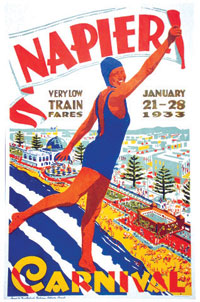Prof Jonathan Woodham presented a keynote address to the Annual Conference of the Society of Architectural Historians
15 Aug 2013
1930s Architecture in Napier and Brighton: Annual Conference of the Society of Architectural Historians
 In September in Napier, New Zealand, Professor Jonathan Woodham presented a keynote address to the Annual Conference of the Society of Architectural Historians of Australia and New Zealand (SAHANZ) under the title 'An Outsider Looking In: Seaside Deco in Napier from a Brighton Perspective'.
In September in Napier, New Zealand, Professor Jonathan Woodham presented a keynote address to the Annual Conference of the Society of Architectural Historians of Australia and New Zealand (SAHANZ) under the title 'An Outsider Looking In: Seaside Deco in Napier from a Brighton Perspective'.
In his paper Jonathan Woodham made comparisons with the post-1931 earthquake architecture of Napier, New Zealand, with that of interwar Brighton, a town that had inspired Napier’s original Marine Parade. Both had strong preservation societies: Brighton and Hove’s Regency Society, having been established immediately after the Second World War, and Napier’s Art Deco Trust, the origins of which lay in the 1980s. Napier, often dubbed ‘The Art Deco Capital of the World’, has a centre dominated by striking 1930s buildings that have become a strong tourist attraction in their own right, whilst Brighton has done much (until the recent “rescue” of Wells Coates’ Embassy Court flats) to knock down or endanger many of the best examples from the same period.
In his talk Woodham also considered aspects of a futuristic, never-built, Brighton seafront stretching from the Adur to the Ouse envisaged in the mid-1930s by Herbert Carden, alongside the visions of town planner Stanley Adshead and R A Hudson in their 1937 Borough Plan. He also looked at the forms and meaning of ornament, particularly in New Zealand which drew on native flora and fauna as a means of providing a distinctive national decorative aesthetic as well as indigenous Maori decorative motifs such as the widely proliferating Kouhaiwhai-inspired patterns that could be found on buildings as well as banknotes and ceramics. He concluded by looking at the tensions between the politics of preservation in Napier and Brighton and the desire of many for architectural forms appropriate to the twenty-first century.
(Image: Napier Carnival Poster, New Zealand Railways, 1933)